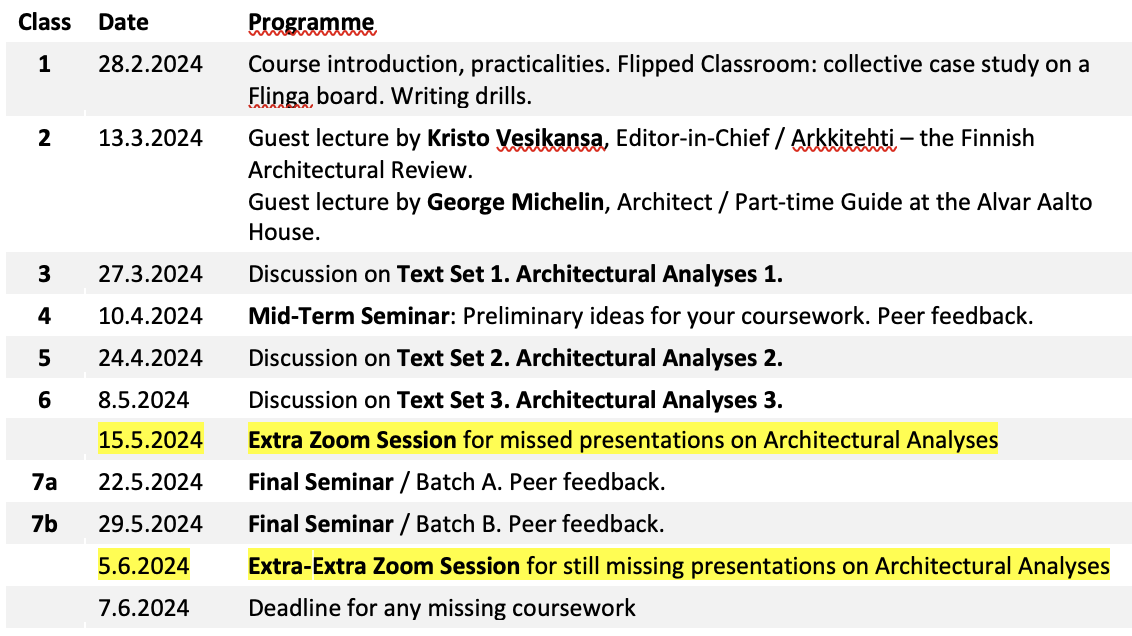ARK-E1029 - Theory of Architecture 2, Lecture, 28.2.2024-29.5.2024
This course space end date is set to 29.05.2024 Search Courses: ARK-E1029
Topic outline
-
Thinking Through Buildings: Architectural Criticism
- Architecture is not a tree but an event, resulting from the intersection of forces capable of situating an object that is partially signifying, contingent. Criticism is thus not the recognition or manifestation of branches but is itself a construct, purposefully produced to cast light on that situation, as a means of drawing the topography of that point where a certain architecture has been produced.
– Ignasi de Solà-Morales, Differences – Topographies of Contemporary Architecture. Transl. Sarah Whiting. Writing Architecture. Cambridge, MA: The MIT Press, 1999, p. 15.ARK-E1029 Theory of Architecture 2 is an advanced course in architectural theory. In spring 2024, the course focuses on architectural criticism, its role within architectural discourse, and its possibilities to create critical re-readings of canonized Finnish architecture.
We'll meet on campus in Väre Q103 (classes in May in Q202); online participation is also possible if needed.
Course Programme 2024

Course Contents
The course consists of three components that entail following coursework:
- Learning & Discussion: This component deals with our guest lectures and course literature. Regarding the lectures, you will contribute on a collective Flinga board with your critical notes (Class 2). Regarding literature, you a) read the given texts and write a short Reading Report that summarizes your interpretation of their contents (recommended length c. 600 words / 2–3 pages); and b) present a Discussion Point: an argument that stems from the literature and that you want to defend and discuss with your fellow students at class (Classes 3, 5 and 6).
- Architectural Analysis: This component is our subject matter: buildings, urban space, and the built environment. You will visit three (3) buildings from the list of course Case Buildings (see below) and prepare a short, but critical study of each of them. You will prepare one (1) slide that summarises your main findings and critical viewpoints in each case and present it at class (Classes 3, 5 and 6).
- Argumentation: This component refers to your final course project, and the idea is to provide a platform to practice your skills as a critic and discuss your own critical perspectives towads architecture. You can choose a cross-cutting take on our Case Buildings or an architectural phenomenon or theory that you find intriguing regarding the shortlist from today's perspective. You can build your project to discuss them all or focus on only one particular theme that connects them in your view. You can elaborate their typology, programme, style, historical era, societal concerns, technological advancements, or whatever interests you the most. You can also choose whatever theoretical perspective you find relevant. You are encouraged to use further literature and you may
add comparative buildings outside of the course’s case buildings if you
like.
To discuss your viewpoint, you will first prepare a draft (one slide and a 5-minute oral presentation + a preliminary abstract of max 200 words) for our Mid-Term Seminar (Class 4). These drafts will be orally peer-reviewed so that each student will act as a critic and each student will receive constructive feedback to develop their final presentation.
For your finalised coursework, you will prepare an illustrated article (c. 1500 words) and a short presentation (c. 5 slides / 10 minutes) for our Final Seminar (Classes 7a or 7b according to your choice). Again, all the presentations will be orally peer-reviewed to practice the art of analytical and constructive criticism.
The course will meet on campus, but there is a Zoom space to use for online participation if needed. In order to ensure a discursive mode of working, the maximum group size in this course is 20 students.Please see Class Rules & Instructions and Self-Evaluation and Assessment Criteria for further details on the course practicalities and the assignments.
Case Buildings
For our Architectural Analyses, we will study the following works:
- Aalto House, Munkkiniemi, Helsinki (Aino and Alvar Aalto, 1936)
- Temppeliaukio Church, Helsinki (Timo and Tuomo Suomalainen, competition 1961, completed 1969)
- Vallila Library (Juha Leiviskä and Asta Björklund 1990)
- Kiasma Museum of Contemporary Art (Steven Holl, competition 1993, completed 1998)
- Löyly, Helsinki (Avanto Architects, 2016)
- Helsinki Central Library Oodi (ALA Architects, competition 2012–13, completed 2018)
Deadlines
- The three Text Sets and their Discussion Points are due on Mondays preceding the class Wednesdays.
- The Architectural Analyses are due on the class Wednesdays; please see our course programme.
- Mid-Term Seminar Abstract Drafts are due on Monday 8th April on the seminar week. The student folder to help peer reviewing will sync automatically with the submissions.
- Final Seminar works are due on Wednesday
15th22nd May. The student folder to help peer reviewing will sync automatically with the submissions. Peer-reviews and Self-Evaluation are due 7th June, as is all missing coursework (please let me know if you can't make this).
Extra Class for missed Architectural Analyses
Did you miss a class and an opportunity to present your Architectural Analysis? Please meet me on Zoom on Wednesday the 15th May or 6th June at 9.15; looking forward to hearing your commentary.
